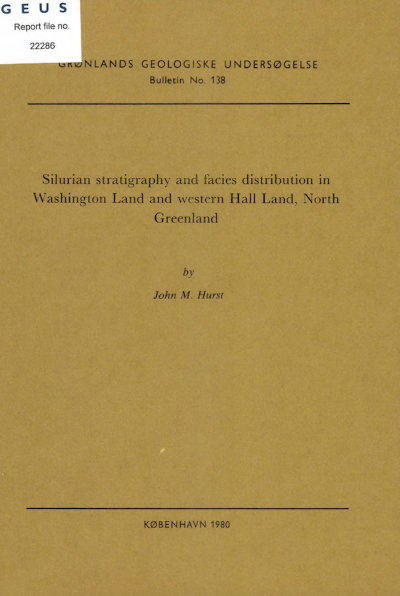Silurian stratigraphy and facies distribution in Washington Land and western Hall Land, North Greenland
DOI:
https://doi.org/10.34194/bullggu.v138.6680Abstract
A new lithostratigraphic scheme is erected for the Silurian rocks of Washington Land and western Hall Land, North Greenland. The lowermost Silurian sediments are grouped with underlying Ordovician rocks in the Morris Bugt Group. The remaining Silurian platform carbonate sediments are included in the Washington Land Group (new) whilst basin slope rocks are assigned to the Peary Land Group (new). Following the Morris Bugt Group Silurian sediments were deposited in two main environments, platform and basin slope. Sediments in these settings are completely different, the platform is characterised by carbonates and the basin slope by mudstones, cherts and resedimented conglomerates. The hinge between platform and basin slope is characterised by abrupt and complex facies changes and in some areas carbonate buildups and megabreccias. The platform succession is at maximum 2 km thick whilst the basin slope sediments are about 600 m thick. The platform region subsided very unequally and two major periods of platform subsidence are recognisable; late Cincinnatian to early Llandovery and late Llandovery to early Wenlock. Four formations are included in the Morris Bugt Group, of which the uppermost Aleqatsiaq Fjord Formation straddles the Ordovician – Silurian boundary. The Washington Land Group is divisible into 10 formations including: Adams Bjerg Formation (new) composed of marginal marine stromatolitic dolomites with a carbonate buildup – Early(?) to Middle Llandovery Age; Pentamerus Bjerge Formation (new) a carbonate buildup, fringing reef, complex – Middle(?) Llandovery to Wenlock Age; Kap Godfred Hansen Formation (new) composed of submarine fan calcarenites and megabreccias – Middle (?) Llandovery to Wenlock Age; Petermann Halvø Formation (new) composed of marginal to open marine dolomites – Early Llandovery Age (?); Bessels Fjord Formation (new) a carbonate buildup complex – Middle (?) to Late Llandovery age; Offley Island Formation composed of shallow platform biostromes – Late Llandovery Age; Kap Lucie Marie Formation (new) composed of offshore to slope calcarenites and shales – Late Llandovery Age; Kap Morton Formation (new) composed of offshore platform to basin slope (peri-platform) lime mudstones – Wenlock to Ludlow Age; Kap Maynard Formation(new) divisible into Dolomite and Limestone Members (new) composed of offshore platform to basin slope (peri-platform) dolomites, shales and lime mudstones – Wenlock to Ludlow Age; Hauge Bjerge Formation (new) divisible into Cape Tyson Member and Kap Independence Member (new) a carbonate buildup complex – Middle (?) Llandovery to Wenlock Age. The Peary Land Group is divisible into two formations including: Cape Schuchert Formation composed of basin slope and starved basin, calcarenites, cherts and black limestones – Middle to early Late Llandovery Age; Lafayette Bugt Formation (new) composed of basin slope shales and conglomerates – Middle Llandovery to Ludlow Age.
Downloads
Published
Issue
Section
License
This article is distributed under a CC-BY 4.0 licence, permitting free redistribution and reproduction for any purpose, even commercial, provided proper citation of the original work. Author(s) retain copyright over the article contents.


